Export To Excel in Xamarin DataGrid (SfDataGrid)
10 Jan 202524 minutes to read
The SfDataGrid supports exporting the data to Excel with several customization options like custom appearance, excluding specific columns, excluding headers, setting custom row height, setting custom column width, etc.
The following assemblies should be added for exporting the SfDataGrid to Excel file.
| Project | Required assemblies |
|---|---|
| PCL | pcl\Syncfusion.SfGridConverter.XForms.dll pcl\Syncfusion.Compression.Portable.dll pcl\Syncfusion.Pdf.Portable.dll pcl\Syncfusion.XlsIO.Portable.dll |
If you are using nuget package in the package, the following NuGet package should be installed to export the SfDataGrid to Excel file.
| Project | Required package |
|---|---|
| Xamarin.Forms | Syncfusion.Xamarin.DataGridExport |
The following code sample demonstrates how to create and display a SfDataGrid in view.
<Grid>
<Grid.RowDefinitions>
<RowDefinition Height="Auto"/>
<RowDefinition />
</Grid.RowDefinitions>
<StackLayout Grid.Row="0" Orientation="Vertical">
<Button x:Name="Excel" Text="ExportExcel" Clicked ="ExportToExcel_Clicked" HeightRequest="50" />
</StackLayout>
<sfgrid:SfDataGrid x:Name="dataGrid"
AllowGroupExpandCollapse="True"
AllowSorting="True"
Grid.Row="1"
SelectionMode="Multiple"
ColumnSizer="None"
ItemsSource="{Binding OrdersInfo}"
AutoGenerateColumns="False" >
<sfgrid:SfDataGrid.Columns>
<sfgrid:GridTextColumn HeaderText="Order ID" MappingName="OrderID"/>
<sfgrid:GridTextColumn HeaderText="First Name" MappingName="FirstName"/>
<sfgrid:GridTextColumn HeaderText="Employee ID" MappingName="EmployeeID"/>
<sfgrid:GridNumericColumn HeaderText="Freight" MappingName="Freight"/>
<sfgrid:GridTextColumn HeaderText="Is Closed" MappingName="IsClosed"/>
<sfgrid:GridTextColumn HeaderText="Ship City" MappingName="ShipCity"/>
<sfgrid:GridDateTimeColumn HeaderText="Shipping Date" MappingName="ShippingDate" />
</sfgrid:SfDataGrid.Columns>
</sfgrid:SfDataGrid>
</Grid>private void ExportToExcel_Clicked(object sender, EventArgs e)
{
// Perform exporting to Excel sheet operations here.
}You can export the data to Excel by using the DataGridExcelExportingController.ExportToExcel method by passing the SfDataGrid as an argument.
private void ExportToExcel_Clicked(object sender, EventArgs e)
{
DataGridExcelExportingController excelExport = new DataGridExcelExportingController();
var excelEngine = excelExport.ExportToExcel(this.dataGrid);
var workbook = excelEngine.Excel.Workbooks[0];
MemoryStream stream = new MemoryStream();
workbook.SaveAs(stream);
workbook.Close();
excelEngine.Dispose();
Xamarin.Forms.DependencyService.Get<ISave>().Save("DataGrid.xlsx", "application/msexcel", stream);
}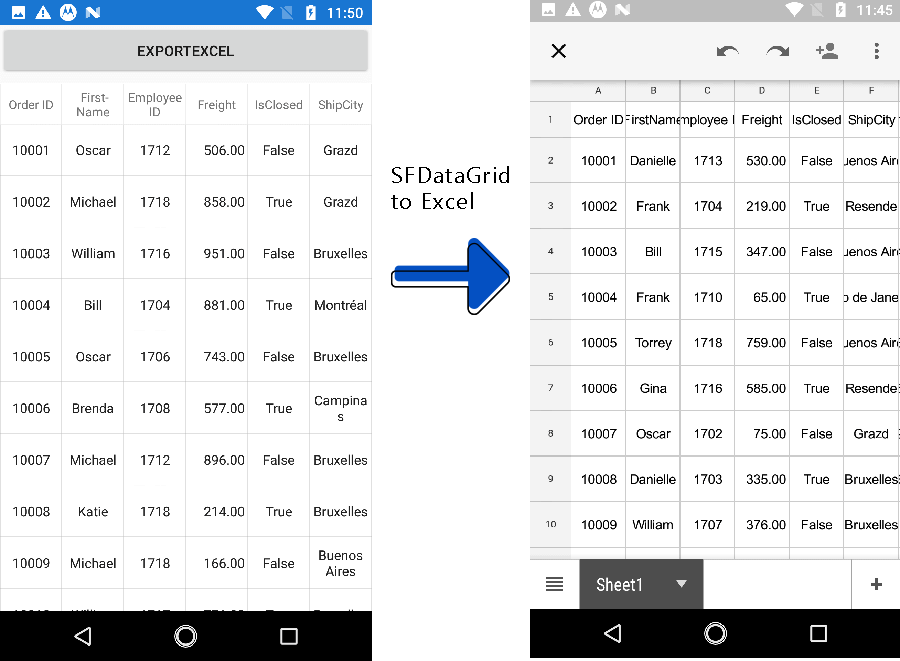
NOTE
SfDataGrid cannot export the GridTemplateColumn to PDF or Excel, since we cannot get the loaded views and draw them with the particular range, values etc from GridTemplateColumn.
Exporting Options
You can also export the data to Excel with various customizing options by passing the grid and DataGridExcelExportingOption as arguments to the ExportToExcel method.
DataGridExcelExportingController excelExport = new DataGridExcelExportingController ();
DataGridExcelExportingOption exportOption = new DataGridExcelExportingOption ();
exportOption.ExportColumnWidth = false;
exportOption.DefaultColumnWidth = 150;
var excelEngine = excelExport.ExportToExcel (this.dataGrid, exportOption);The SfDataGrid provides several properties in DataGridExcelExportingOption class to customize the grid while exporting it to Excel.
Exporting formatted text and actual value
By default, the actual value will only be exported to Excel. To export the display text, set the ExportMode property as Text.
DataGridExcelExportingController excelExport = new DataGridExcelExportingController ();
DataGridExcelExportingOption options = new DataGridExcelExportingOption ();
options.ExportMode = ExportMode.Text;
var excelEngine = excelExport.ExportToExcel(dataGrid, options);
var workBook = excelEngine.Excel.Workbooks[0];Getting RowIndex, ColumnIndex and GridColumns for customization
ExcelColumnIndex
The ExcelColumnIndex Property gets or internally sets the column index being exported to the Excel. Each column is exported based on this index to identify the current exporting column index.
ExcelRowIndex
The ExcelRowIndex Property gets the row index being exported to the Excel. Each row is exported based on this index to identify the current exporting row index.
GridColumns
Using the property System.Collections.IEnumerable columns you can get or set the ExcludedColumns columns collection which contains all the columns that are to be exported. The columns in the ExcludedColumns List will not be a member of the GridColumns collection.
Customize header, groups and table summary when exporting
Export groups
By default, all the groups in the data grid will be exported to Excel sheet. To export the data grid without groups, set the DataGridExcelExportingOption.ExportGroups property to false.
DataGridExcelExportingOption option = new DataGridExcelExportingOption();
option.ExportGroups = true;- ExportGroups = true;

- ExportGroups = false;

Export header
By default, the column headers will be exported to Excel sheet. To export the SfDataGrid without column headers, set the DataGridExcelExportingOption.ExportHeader property to false.
DataGridExcelExportingOption option = new DataGridExcelExportingOption();
option.ExportHeader = false;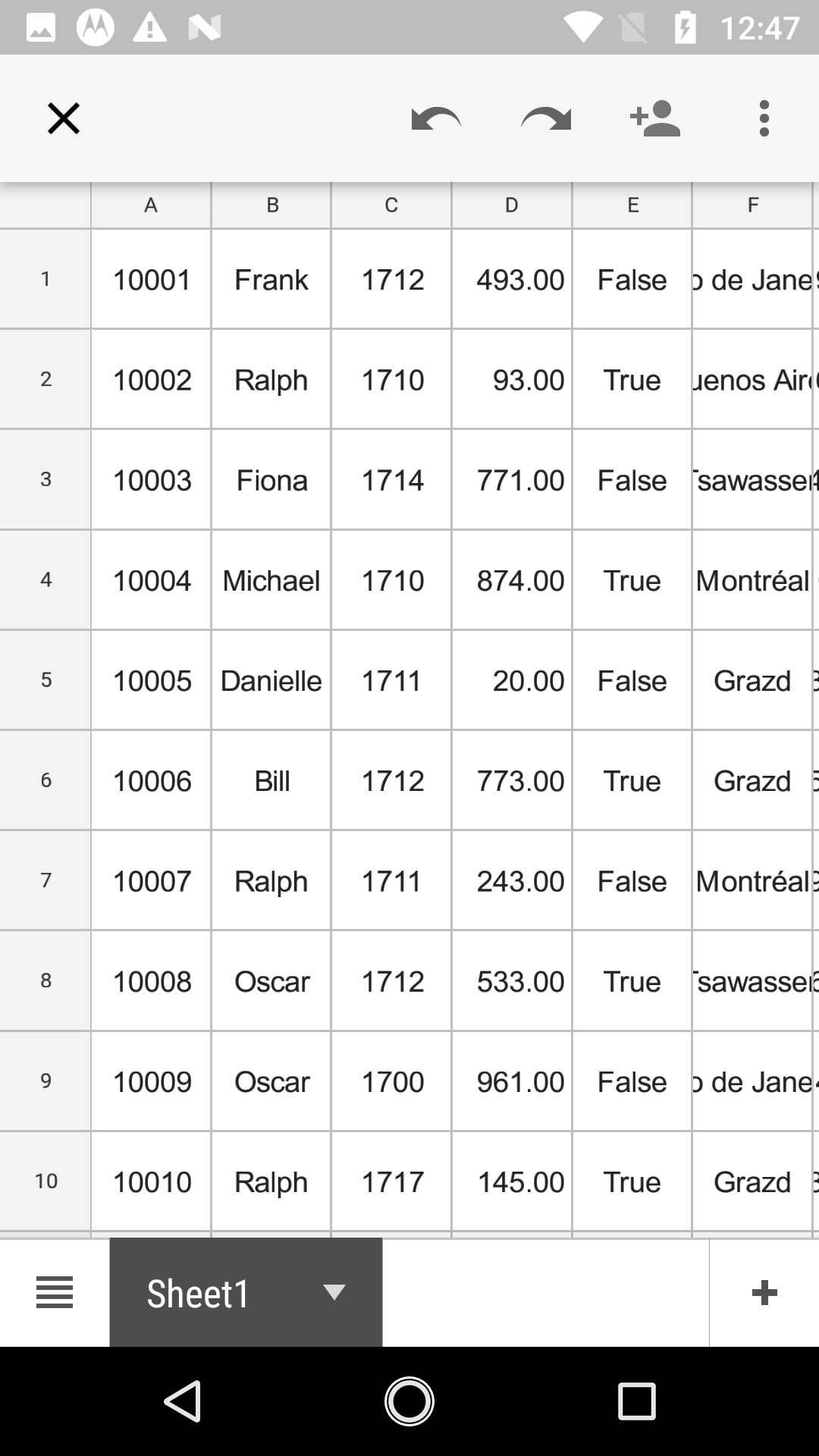
Export table summary
By default, table summaries in the data grid will be exported to Excel. To export the SfDataGrid without table summaries, set the DataGridExcelExportingOption.ExportTableSummary property to false.
DataGridExcelExportingOption option = new DataGridExcelExportingOption();
option.ExportTableSummary = true;- ExportTableSummary = true;

- ExportTableSummary = false;

Export groups with outlines
To export the data grid with applied grouping, enable the group expand or collapse option in the Excel sheet by setting the DataGridExcelExportingOption.AllowOutlining to true. The default value of this property is false so, you cannot expand or collapse the group in the Excel sheet.
DataGridExcelExportingOption option = new DataGridExcelExportingOption();
option.AllowOutlining = true;Exclude columns when exporting
By default, all the columns (including hidden columns) in the SfDataGrid will be exported to Excel. To exclude some particular columns when exporting to Excel, add those columns to the DataGridExcelExportingOption.ExcludeColumns property in DataGridExcelExportingOption list.
DataGridExcelExportingOption option = new DataGridExcelExportingOption();
var list = new List<string>();
list.Add("OrderID");
list.Add("LastName");
option.ExcludedColumns = list;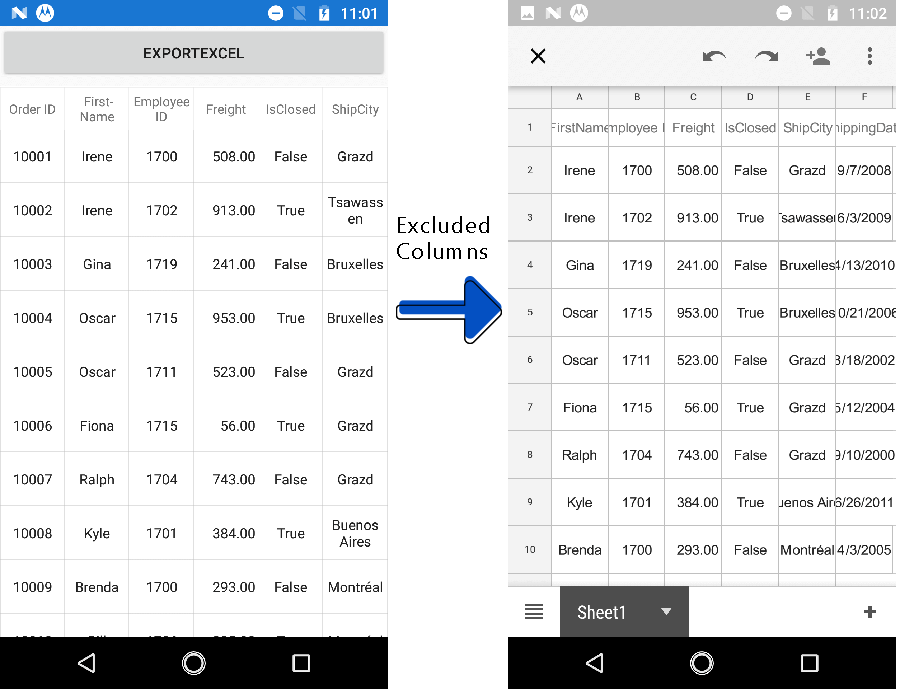
Customize Exporting Excel Version
The SfDataGrid allows exporting the data to Excel in specific versions by using the DataGridExcelExportingOption.ExcelVersion property.
DataGridExcelExportingOption option = new DataGridExcelExportingOption();
option.ExcelVersion = Syncfusion.XlsIO.ExcelVersion.Excel2013;Exporting the grid from a specified row and column index
StartColumnIndex
By default, the exported SfDataGrid will start from the 0th column in the Excel sheet. You can specify the starting column by using the DataGridExcelExportingOption.StartColumnIndex property.
DataGridExcelExportingOption option = new DataGridExcelExportingOption();
option.StartColumnIndex = 4;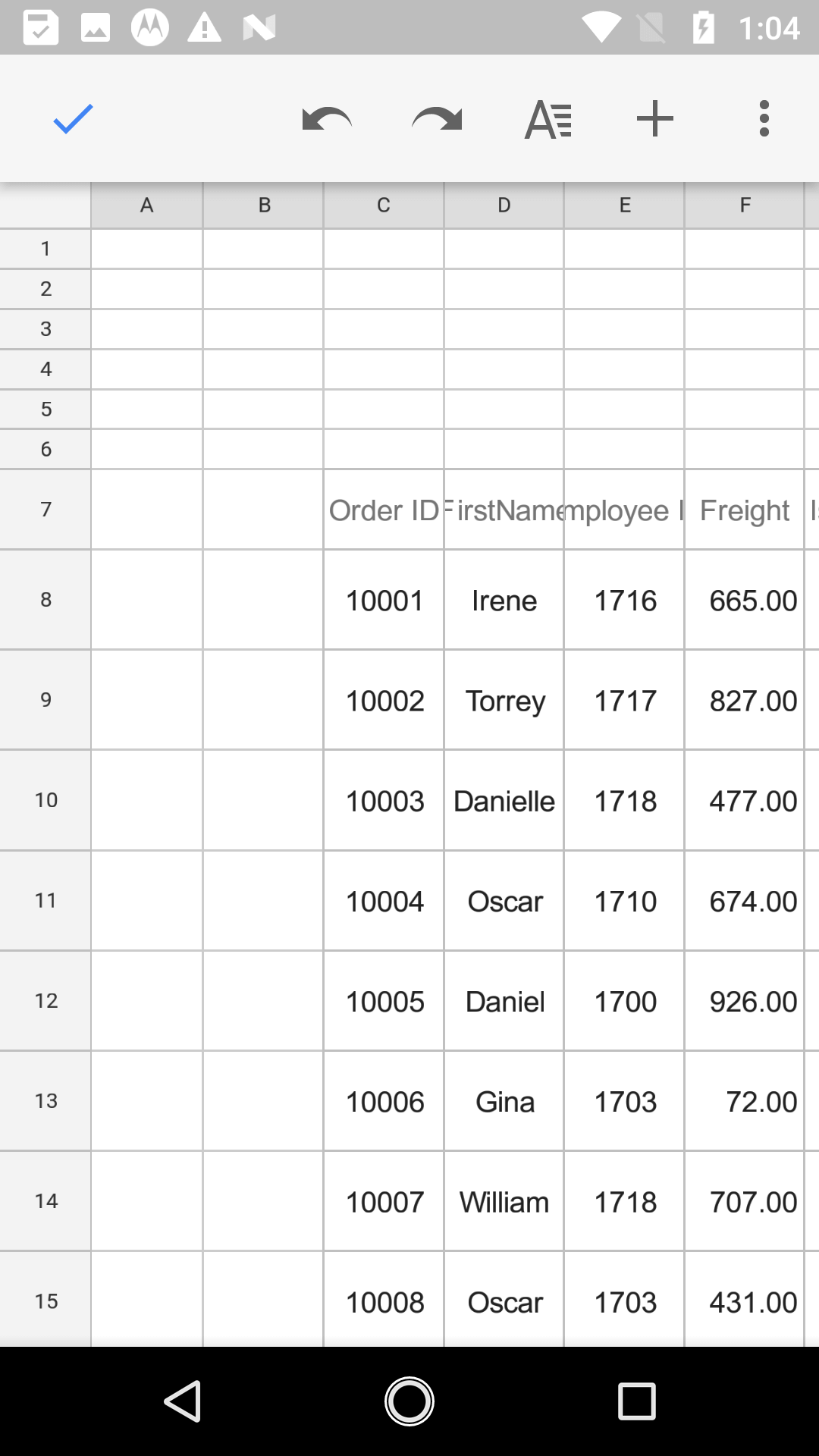
StartRowIndex
By default, the exported SfDataGrid will start from the 0th row in the Excel sheet. You can specify the starting row by using the DataGridExcelExportingOption.StartRowIndex property.
DataGridExcelExportingOption option = new DataGridExcelExportingOption();
option.StartRowIndex = 10;
Exporting with sorting and filtering
The SfDataGrid allows exporting the data grid to Excel with sorting and filtering options enabled on the column header in Excel sheet by setting the DataGridExcelExportingOption.AllowSortingAndFiltering to true. The default value of this property is false.
DataGridExcelExportingOption option = new DataGridExcelExportingOption();
option.AllowSortingAndFiltering = true;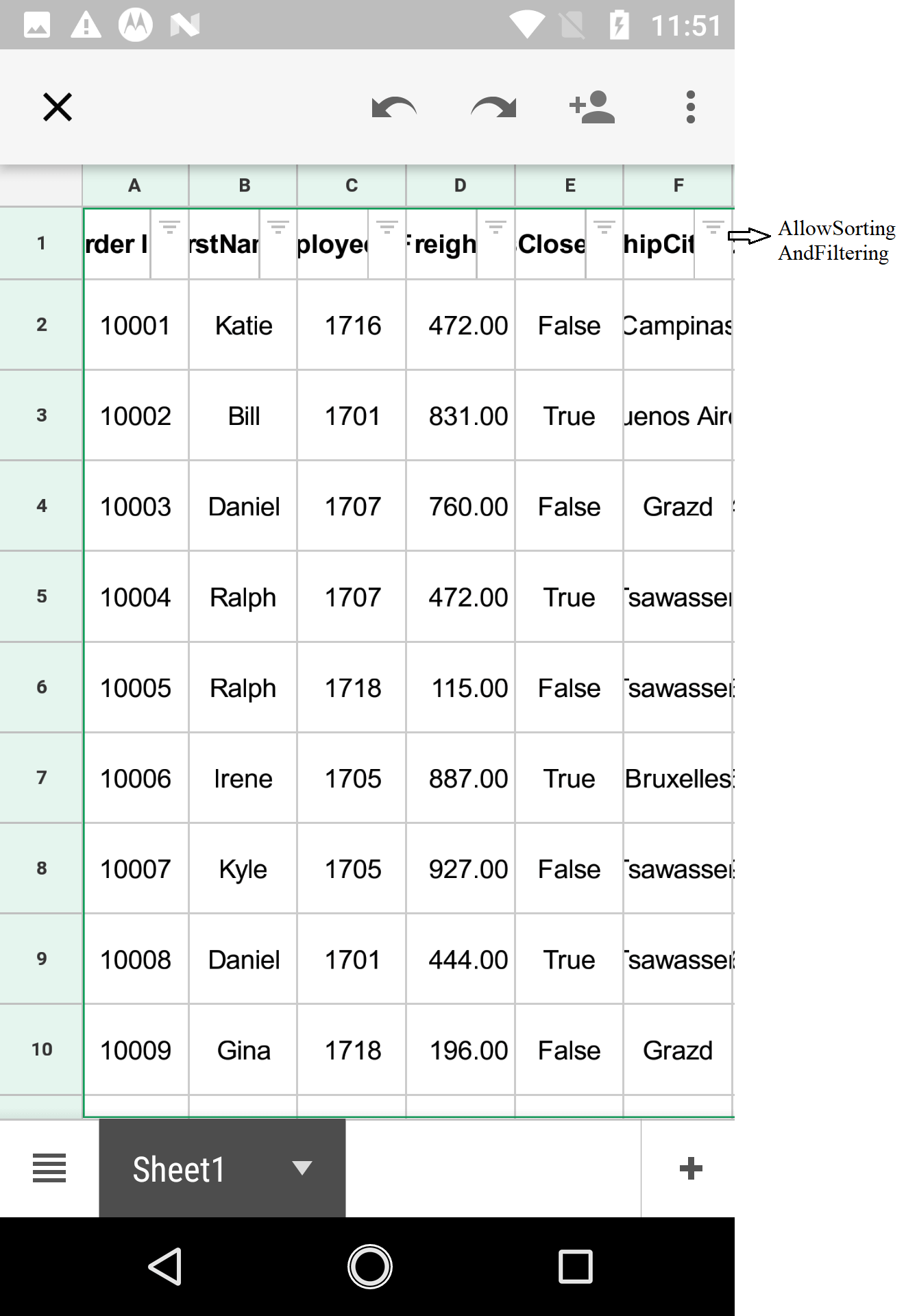
Applying styles while exporting
The SfDataGrid allows exporting the data with the applied GridStyle by setting the DataGridExcelExportingOption.ApplyGridStyle to true. By default, the data will be exported without the GridStyle.
DataGridExcelExportingOption option = new DataGridExcelExportingOption();
option.ApplyGridStyle = true;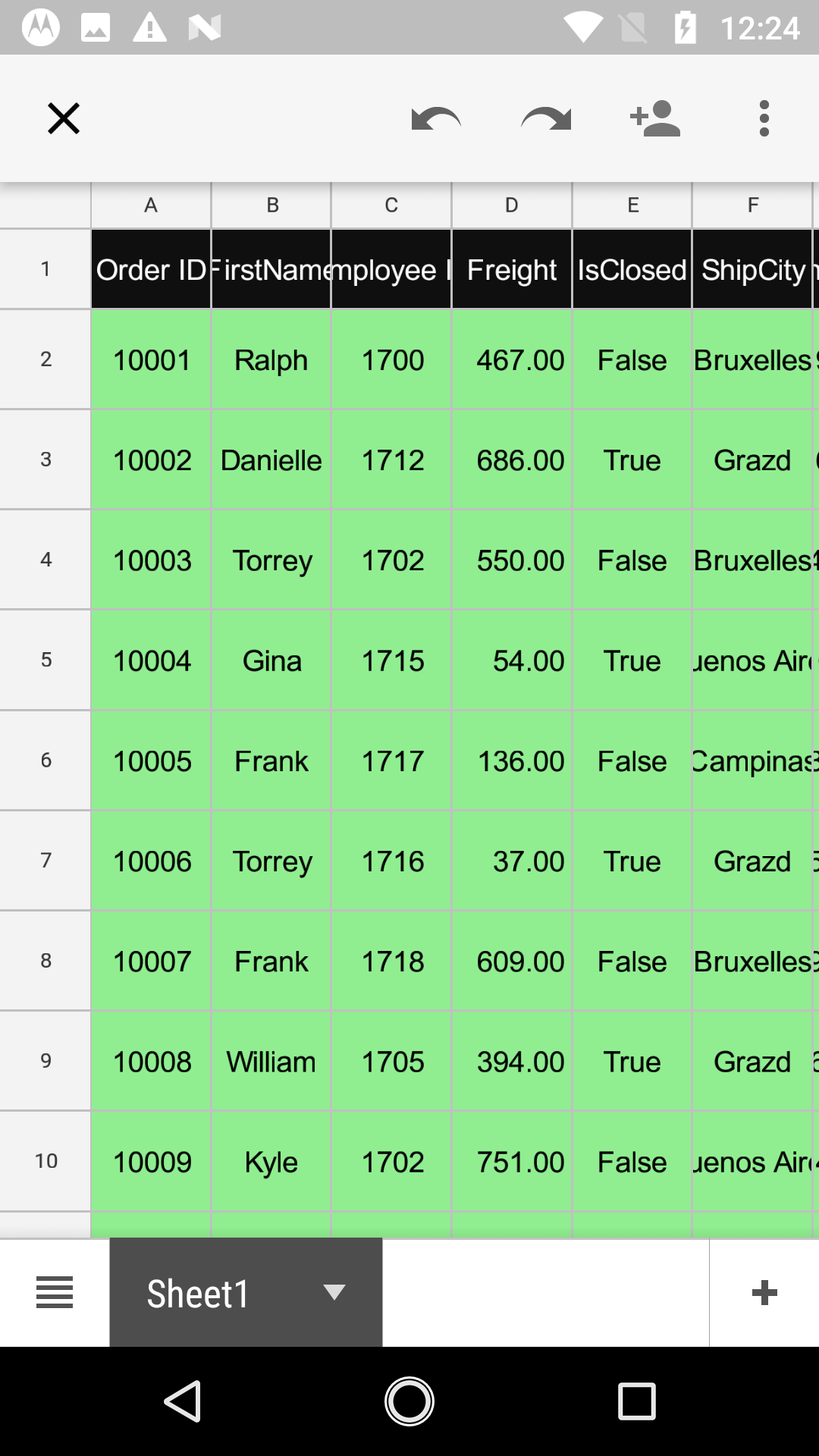
BottomTableSummaryStyle
The SfDataGrid supports exporting the bottom table summary with custom style by using the DataGridExcelExportingOption.BottomTableSummaryStyle property.
DataGridExcelExportingOption option = new DataGridExcelExportingOption();
option.BottomTableSummaryStyle = new ExportCellStyle()
{
BackgroundColor = Xamarin.Forms.Color.Yellow,
BorderColor = Xamarin.Forms.Color.Red,
ForegroundColor = Xamarin.Forms.Color.Green,
};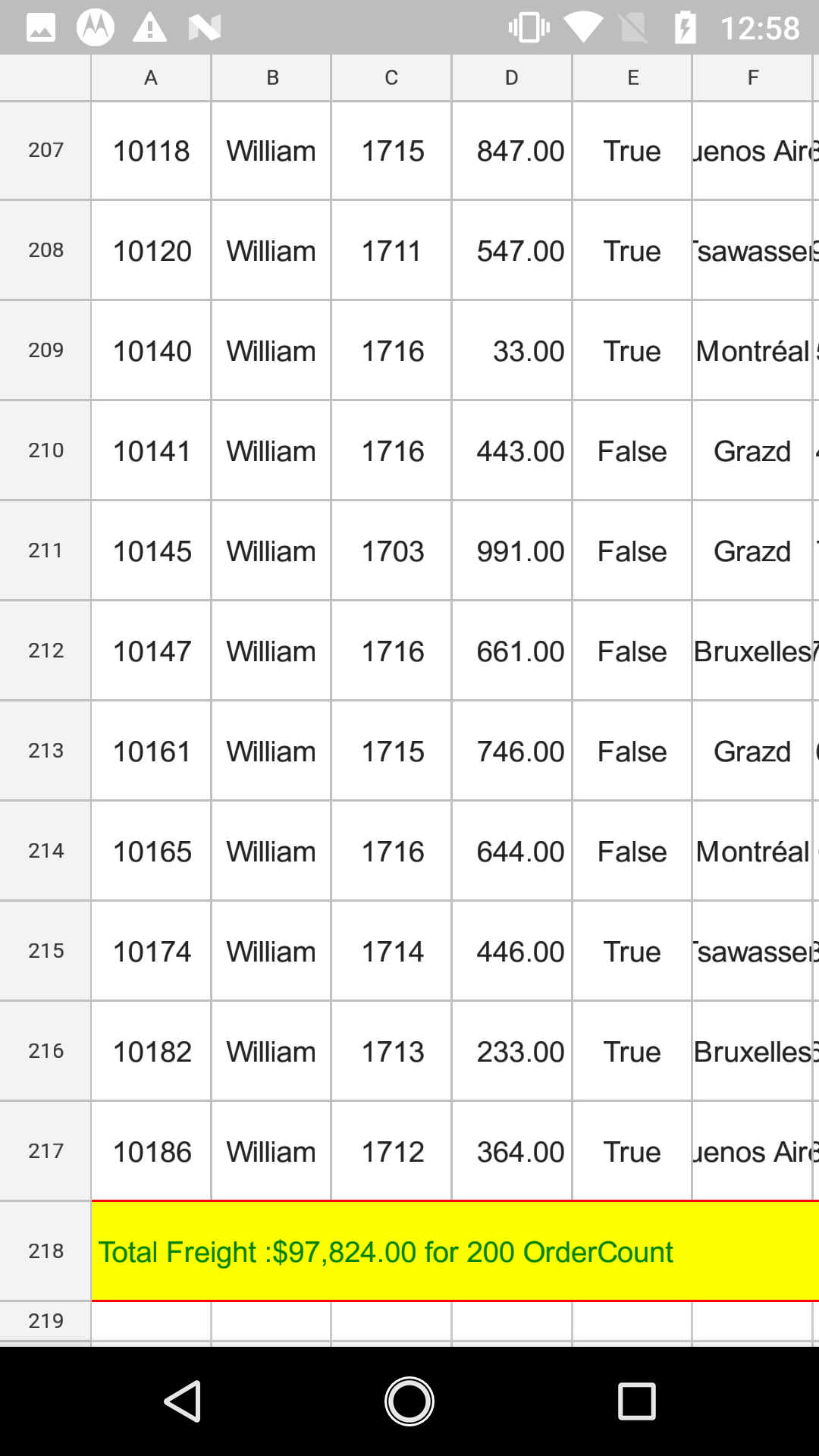
GroupCaptionStyle
The SfDataGrid supports exporting the GroupCaptionSummaries with custom style by using the DataGridExcelExportingOption.GroupCaptionStyle property.
DataGridExcelExportingOption option = new DataGridExcelExportingOption();
option.GroupCaptionStyle = new ExportCellStyle()
{
BackgroundColor = Xamarin.Forms.Color.Yellow,
BorderColor = Xamarin.Forms.Color.Red,
ForegroundColor = Xamarin.Forms.Color.Green,
};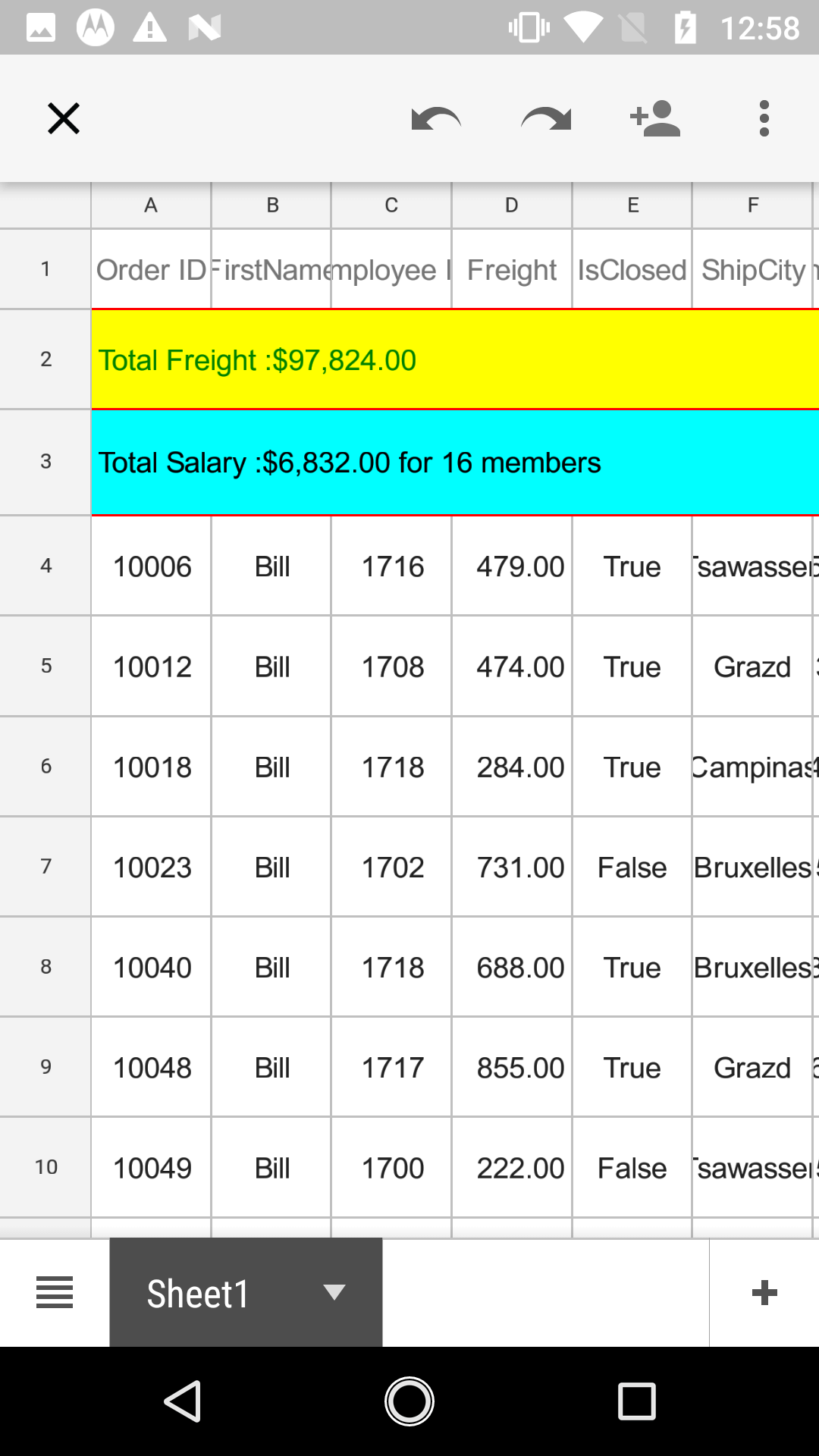
HeaderStyle
The SfDataGrid allows exporting the column headers with custom style by using the DataGridExcelExportingOption.HeaderStyle property.
DataGridExcelExportingOption option = new DataGridExcelExportingOption();
option.HeaderStyle = new ExportCellStyle()
{
BackgroundColor = Xamarin.Forms.Color.Yellow,
BorderColor = Xamarin.Forms.Color.Red,
ForegroundColor = Xamarin.Forms.Color.Green,
};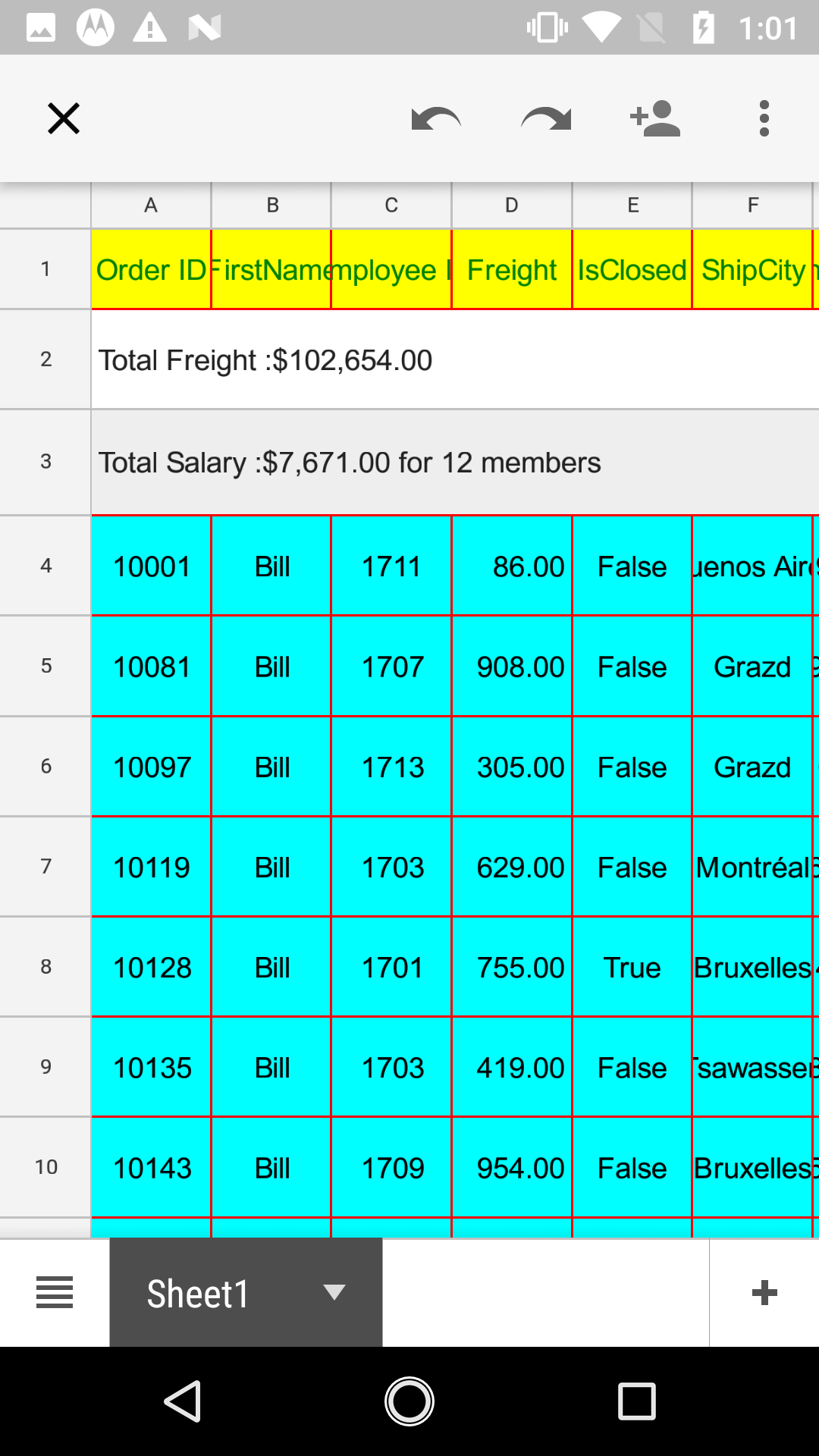
RecordStyle
The SfDataGrid allows exporting the records with custom style by using the DataGridExcelExportingOption.RecordStyle property.
DataGridExcelExportingOption option = new DataGridExcelExportingOption();
option.RecordStyle = new ExportCellStyle()
{
BackgroundColor = Xamarin.Forms.Color.Yellow,
BorderColor = Xamarin.Forms.Color.Red,
ForegroundColor = Xamarin.Forms.Color.Green,
};
TopTableSummaryStyle
The SfDataGrid supports exporting the top table summary with custom style by using the DataGridExcelExportingOption.TopTableSummaryStyle property.
DataGridExcelExportingOption option = new DataGridExcelExportingOption();
option.TopTableSummaryStyle = new ExportCellStyle()
{
BackgroundColor = Xamarin.Forms.Color.Yellow,
BorderColor = Xamarin.Forms.Color.Red,
ForegroundColor = Xamarin.Forms.Color.Green,
};
Exporting Unbound rows
By default, the Unbound rows will not be exported to the excel document. However, you can export the unbound rows to excel by setting the DataGridExcelExportingOption.ExportUnboundRows property as true.
DataGridExcelExportingOption option = new DataGridExcelExportingOption();
option.ExportUnboundRows = true;Exporting unbound columns
The SfDataGrid.GridUnboundColumns will be exported as SfDataGrid.GridTextColumns without specifying any code. You can customize the SfDataGrid.GridUnboundColumns as SfDataGrid.GridTextColumns by using the CellExporting and RowExporting events.
<sfgrid:GridUnboundColumn Expression="OrderID * 12"
HeaderFontAttribute="Bold"
HeaderText="Unbound"
HeaderTextAlignment="Start"
MappingName="Unbound"
Padding="5, 0, 0, 0"
TextAlignment="Start">
</sfgrid:GridUnboundColumn>The following screenshot shows that the unbound column is exported to excel sheet along with text columns.
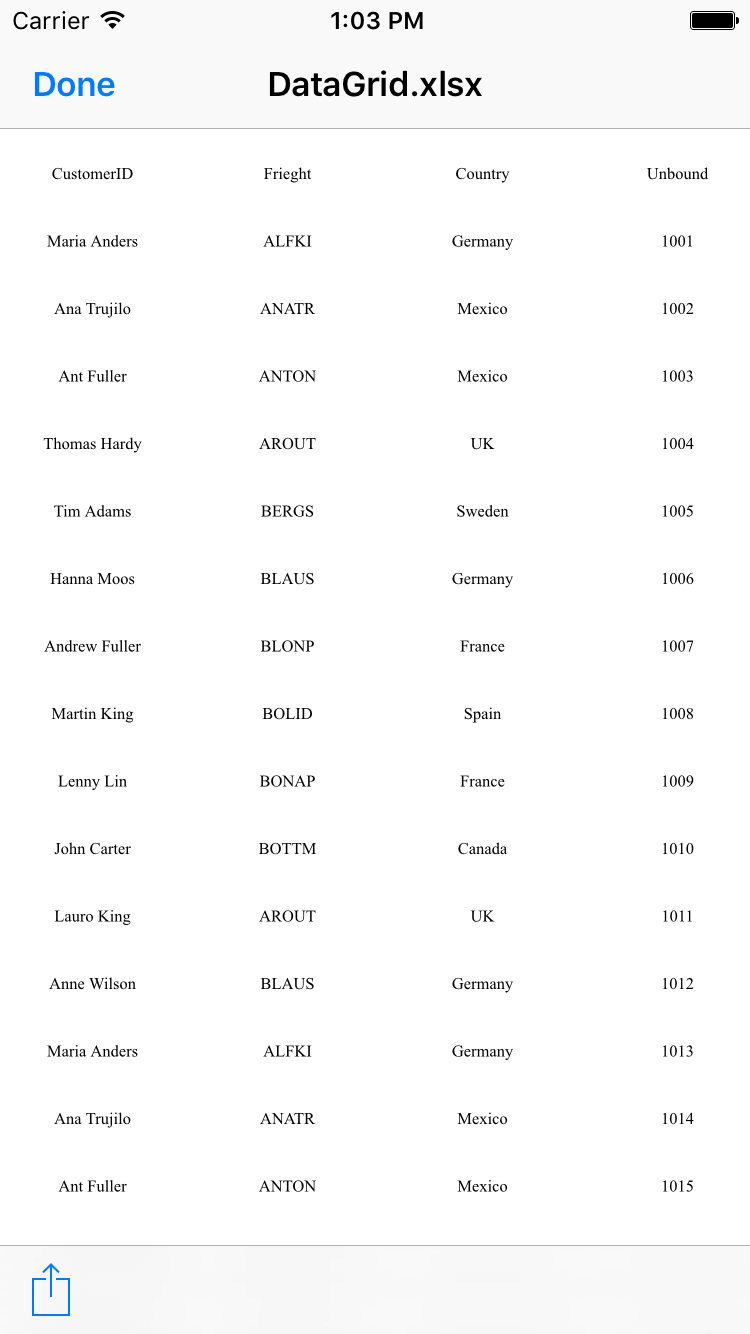
ExportGroupSummary
By default, the GroupSummary rows in the data grid will be exported to Excel. To export the SfDataGrid without group summaries, set the DataGridExcelExportingOption.ExportGroupSummary property to false.
DataGridExcelExportingOption option = new DataGridExcelExportingOption();
// Set false here to export the DataGrid without GroupSummary rows. The default value is true.
// option.ExportGroupSummary = false;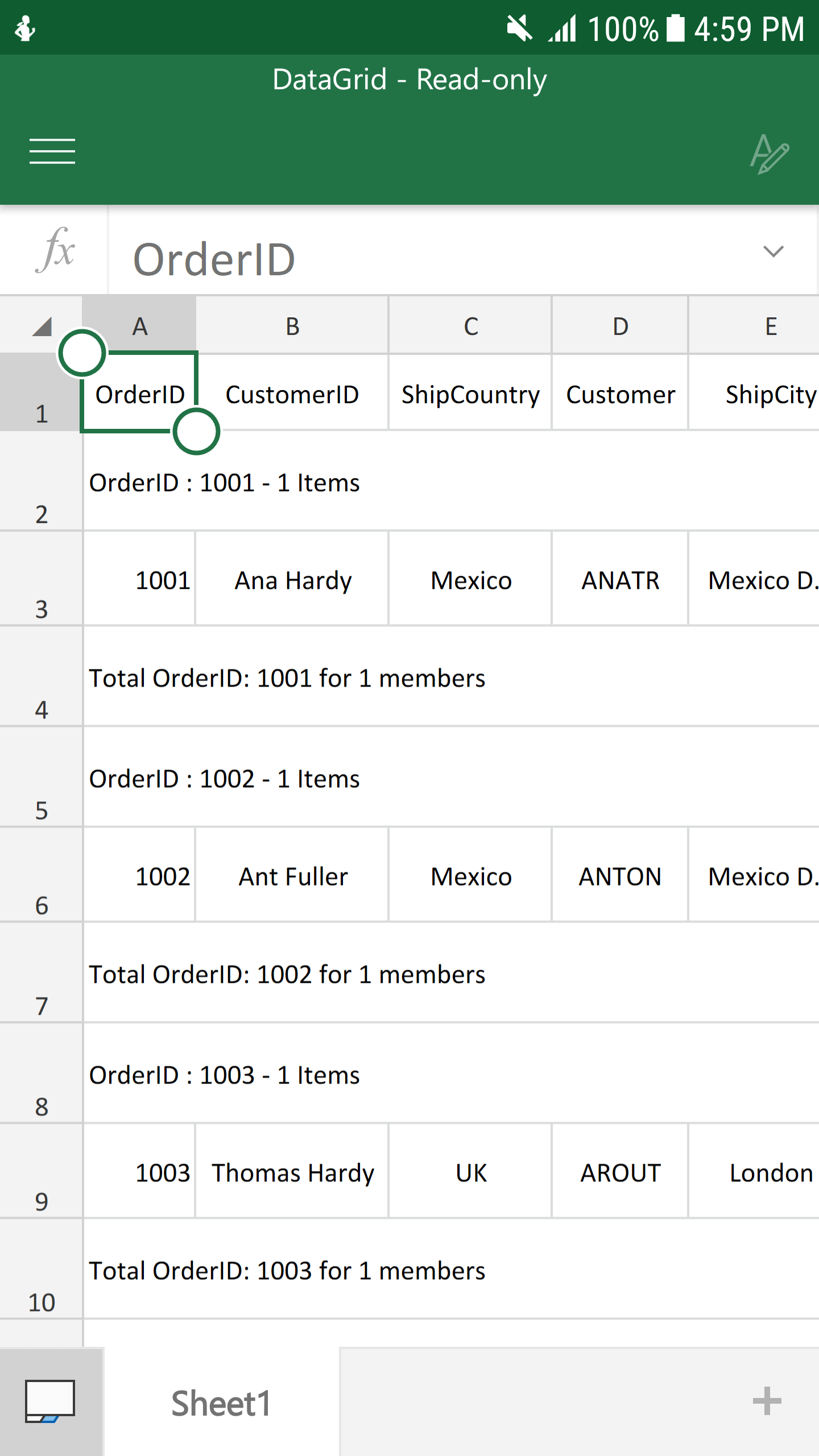
GroupSummaryStyle
SfDataGrid supports exporting the GroupSummary rows with custom style by using the DataGridExcelExportingOption.GroupSummaryStyle property.
DataGridExcelExportingOption option = new DataGridExcelExportingOption();
option.GroupSummaryStyle = new ExportCellStyle()
{
BackgroundColor = Xamarin.Forms.Color.Red,
BorderColor = Xamarin.Forms.Color.Yellow,
ForegroundColor = Xamarin.Forms.Color.White,
};
##Saving options
###Save as stream
var excelExport = new DataGridExcelExportingController();
var options = new DataGridExcelExportingOption();
var excelEngine = excelExport.ExportToExcel(dataGrid, options);
var workBook = excelEngine.Excel.Workbooks[0];
MemoryStream stream = new MemoryStream();
workBook.SaveAs(stream);Export AllPages in datagrid
When exporting to Excel using SfDataPager inside the SfDataGrid, it will only export the current page by default. However, you can export all the pages by setting the DataGridExcelExportingOption.ExportAllPages property to true.
DataGridExcelExportingOption option = new DataGridExcelExportingOption();
option.ExportAllPages = true;- ExportAllPages = true;

- ExportAllPages = false;

Row Height and Column Width customization
DefaultColumnWidth
The SfDataGrid allows customizing the column width in Excel file by using the DataGridExcelExportingOption.DefaultColumnWidth property. The DefaultColumnWidth value will be applied to all the columns in the Excel sheet.
DataGridExcelExportingOption option = new DataGridExcelExportingOption();
option.DefaultColumnWidth = 100;DefaultRowHeight
The SfDataGrid allows customizing the row height in Excel file by using the DataGridExcelExportingOption.DefaultRowHeight property. The DefaultRowHeight value will be applied to all the rows in the Excel sheet.
DataGridExcelExportingOption option = new DataGridExcelExportingOption();
option.DefaultRowHeight = 50;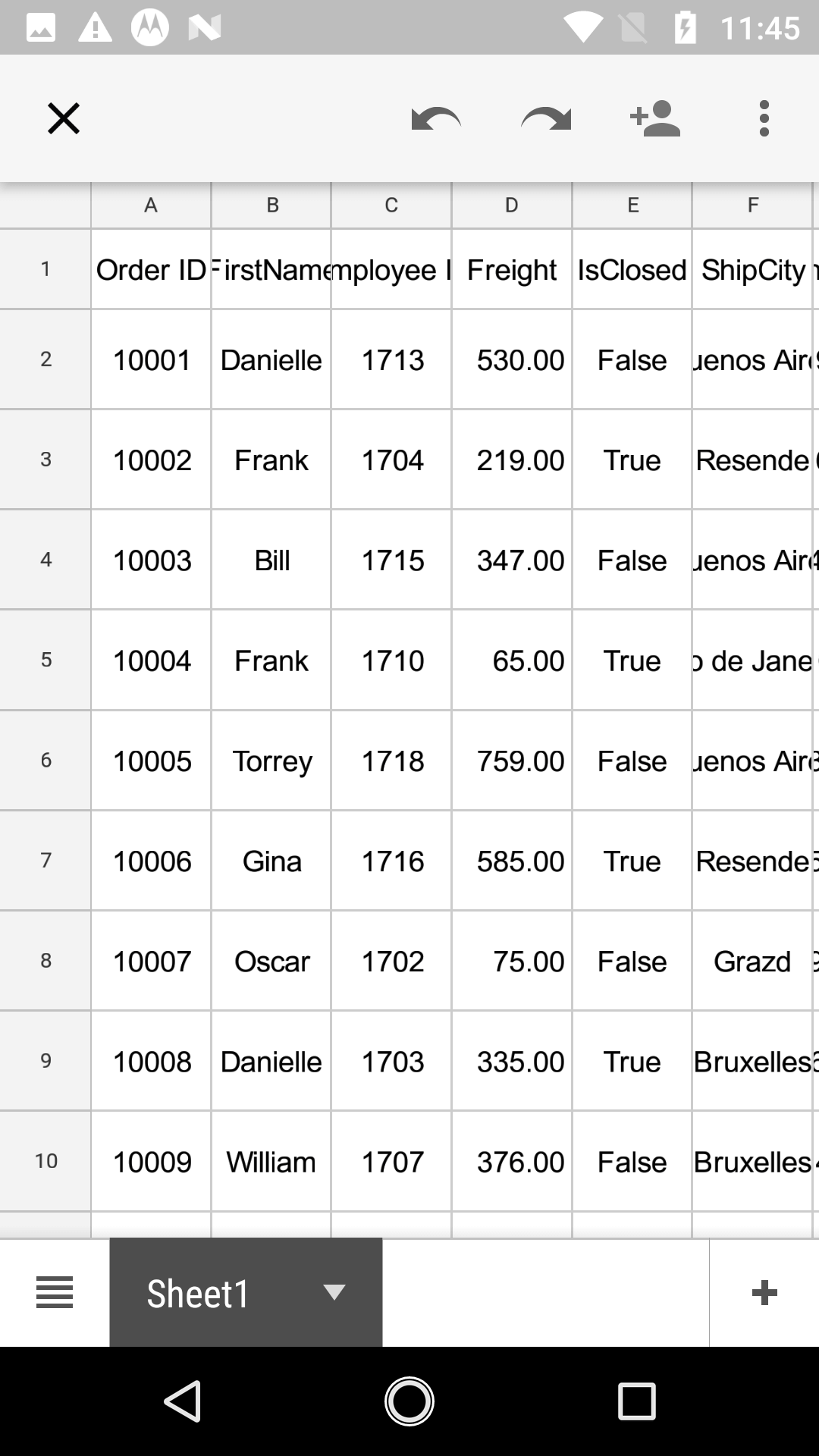
ExportColumnWidth
By default, the data grid columns will be exported to Excel with DataGridExcelExportingOption.DefaultColumnWidth value. You can also export the data grid to Excel with exact column widths by setting the DataGridExcelExportingOption.ExportColumnWidth property to true.
DataGridExcelExportingOption option = new DataGridExcelExportingOption();
option.ExportColumnWidth = true;ExportRowHeight
By default, the data grid rows will be exported to Excel with DataGridExcelExportingOption.DefaultRowHeight value. You can also export the data grid to Excel with exact row heights by setting the DataGridExcelExportingOption.ExportRowHeight property to true.
DataGridExcelExportingOption option = new DataGridExcelExportingOption();
option.ExportRowHeight = true;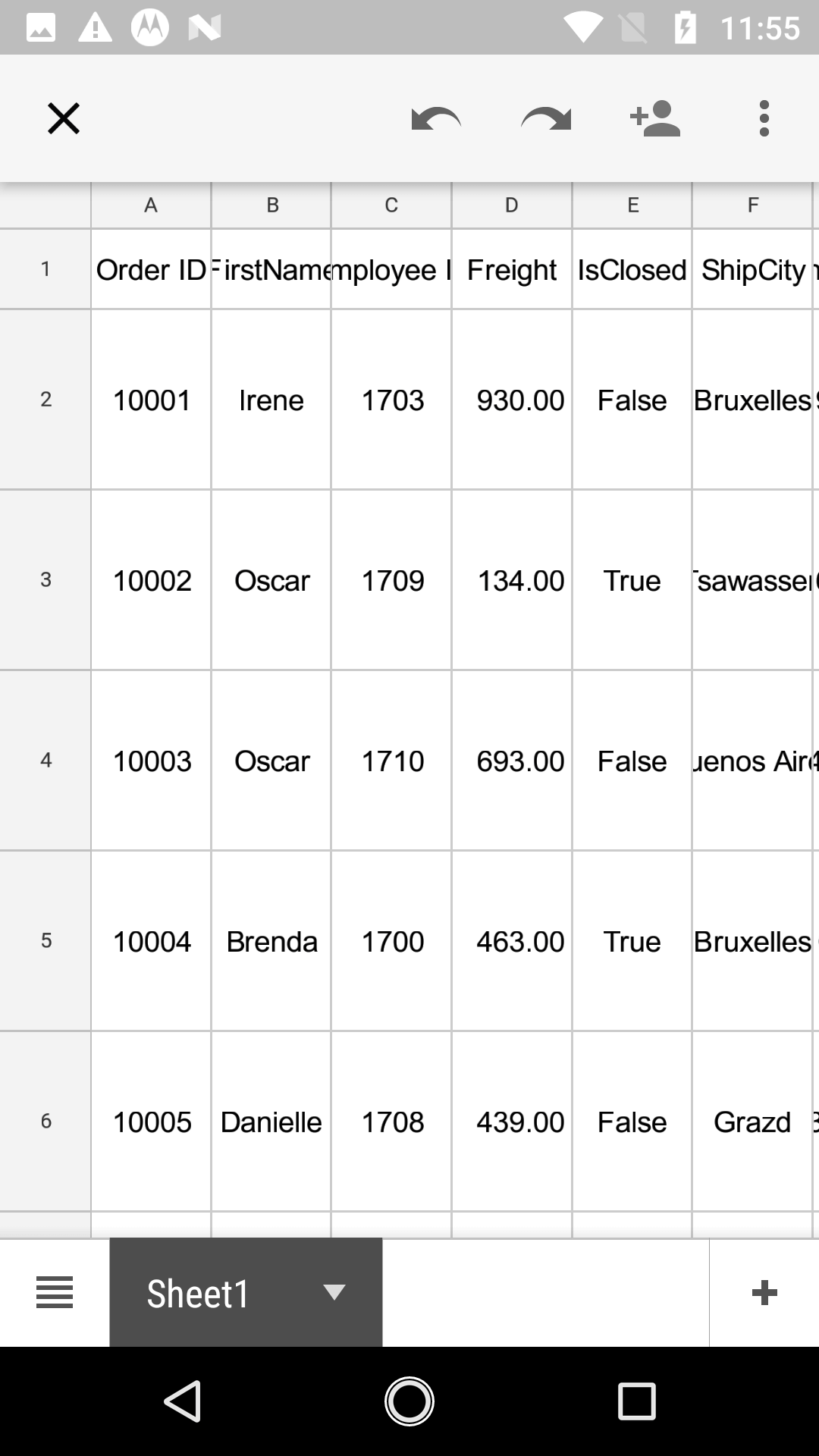
Events
Styling cells based on cell type.
You can customize the row style based on the cell type when exporting to Excel by handling the RowExporting event.
DataGridExcelExportingController excelExport = new DataGridExcelExportingController();
excelExport.RowExporting += ExcelExport_RowExporting;
private void ExcelExport_RowExporting(object sender, DataGridRowExcelExportingEventArgs e)
{
if (!(e.Record.Data is OrderInfo))
return;
if (e.RowType == ExportRowType.Record)
{
e.Range.CellStyle.ColorIndex = Syncfusion.XlsIO.ExcelKnownColors.Red;
}
}Cell customization in Excel while exporting
Customize cell value while exporting
You can customize the cell values when exporting to Excel by handling the CellExporting event.
DataGridExcelExportingController excelExport = new DataGridExcelExportingController();
excelExport.CellExporting += ExcelExport_CellExporting;
private void ExcelExport_CellExporting(object sender, DataGridCellExcelExportingEventArgs e)
{
if (e.CellType == ExportCellType.RecordCell && e.ColumnName == "IsClosed")
{
if ((bool)e.CellValue)
e.CellValue = "Y";
else
e.CellValue = "N";
}
}Changing row style in Excel based on data
You can customize the row style based on the row data when exporting to Excel by handling the RowExporting event.
DataGridExcelExportingController excelExport = new DataGridExcelExportingController();
excelExport.RowExporting += ExcelExport_RowExporting;
private void ExcelExport_RowExporting(object sender, DataGridRowExcelExportingEventArgs e)
{
if (!(e.Record.Data is OrderInfo))
return;
if (e.RowType == ExportRowType.Record)
{
if ((e.Record.Data as OrderInfo).IsClosed)
e.Range.CellStyle.ColorIndex = Syncfusion.XlsIO.ExcelKnownColors.Yellow;
else
e.Range.CellStyle.ColorIndex = Syncfusion.XlsIO.ExcelKnownColors.Red;
}
}Customize the cells based on column name
You can customize the column style based on the row data when exporting to Excel by handling the CellExporting event.
DataGridExcelExportingController excelExport = new DataGridExcelExportingController();
excelExport.RowExporting += ExcelExport_RowExporting;
private void ExcelExport_RowExporting(object sender, DataGridRowExcelExportingEventArgs e)
{
if (!(e.Record.Data is OrderInfo))
return;
if (e.CellType == ExportCellType.RecordCell && e.ColumnName == "FirstName")
{
e.Range.CellStyle.ColorIndex = Syncfusion.XlsIO.ExcelKnownColors.Red;
}
}The SfDataGrid provides the following events when exporting to Excel:
- RowExporting: Raised when exporting a row at the execution time.
- CellExporting: Raised when exporting a cell at the execution time.
Row exporting
The DataGridRowExcelExportingEventHandler delegate allows customizing the styles for record rows and group caption rows. The RowExporting event is triggered with DataGridRowExcelExportingEventArgs that contains the following properties:
- Range: Specifies the Excel range to be exported. It provides full access to the exporting cell in Excel.
- Record: Gets the collection of the exported underlying data objects.
-
RowType: Specifies the row type by using
ExportRowTypeenum. You can use this property to check the row type and apply different styles based on the row type. -
Worksheet: Sets the
Worksheetproperties such as sheet protection, gridlines, and so on.
You can use these events to customize the properties of exported grid rows. The following code example illustrates how to change the background color of the record rows and caption summary rows when exporting.
//HandlingRowExportingEvent for exporting to excel
DataGridExcelExportingController excelExport = new DataGridExcelExportingController ();
excelExport.RowExporting += excelExport_RowExporting;
void excelExport_RowExporting (object sender, DataGridRowExcelExportingEventArgs e)
{
if (e.RowType == ExportRowType.Record) {
if ((e.Record.Data as OrderInfo).IsClosed)
e.Range.CellStyle.ColorIndex = Syncfusion.XlsIO.ExcelKnownColors.Yellow;
else
e.Range.CellStyle.ColorIndex = Syncfusion.XlsIO.ExcelKnownColors.LightGreen;
}
if (e.RowType == ExportRowType.CaptionSummary) {
e.Range.CellStyle.ColorIndex = Syncfusion.XlsIO.ExcelKnownColors.Grey_25_percent;
}
}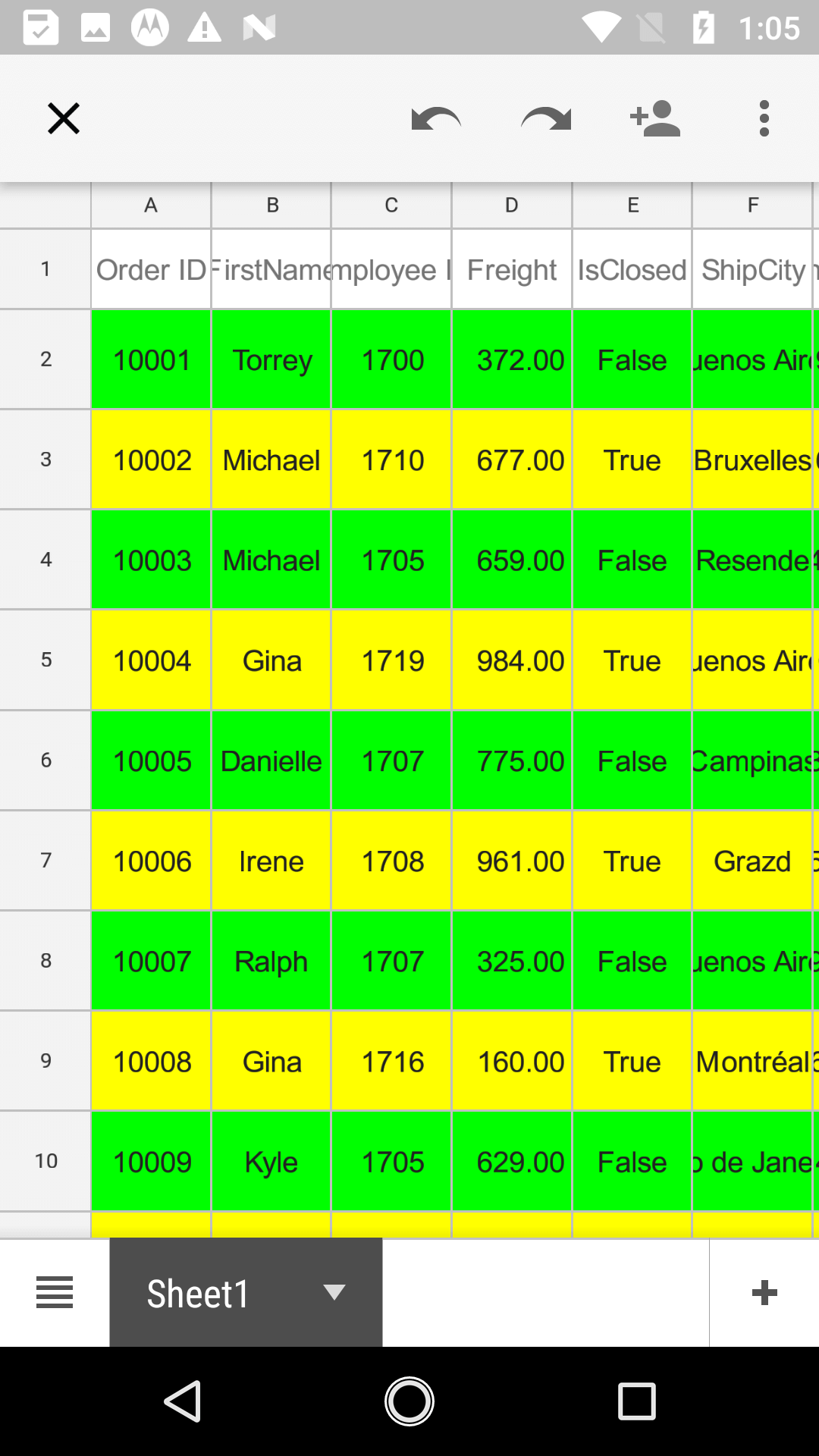
CellExporting
The DataGridCellExcelExportingEventHandler delegate allows customizing the styles for header cells, record cells, and group caption cells. The CellExporting event is triggered with DataGridCellExcelExportingEventArgs that contains the following properties:
-
CellType: Specifies the cell type by using
ExportCellTypeenum. Checks the cell type and apply different cell styles based on the cell type. -
CellValue: Contains the exported actual value. Applies formatting in Excel by using the
Rangeproperty. -
ColumnName: Specifies the column name (MappingName) of the exporting cell. You can apply formatting for a particular column by checking the
column name. - Handled: Determines whether the cell is exported to Excel or not.
- Range: Specifies the Excel range to be exported. It provides full access to the exporting cell in Excel.
- Record: Gets the collection of the exported underlying data objects.
You can use these events to customize the properties of the grid cells exported to excel. The following code example illustrates how to customize the background color, foreground color, and cell value of the header cells, record cells, and caption summary cells when exporting.
//HandlingCellExportingEvent for exporting to Excel
DataGridExcelExportingController excelExport = new DataGridExcelExportingController ();
excelExport.CellExporting += excelExport_CellExporting;
void excelExport_CellExporting(object sender, DataGridCellExcelExportingEventArgs e)
{
if (e.CellType == ExportCellType.HeaderCell) {
e.Range.CellStyle.ColorIndex = Syncfusion.XlsIO.ExcelKnownColors.Blue;
e.Range.CellStyle.PatternColorIndex = Syncfusion.XlsIO.ExcelKnownColors.White;
e.Range.CellStyle.BeginUpdate();
e.Range.CellStyle.Borders.LineStyle = Syncfusion.XlsIO.ExcelLineStyle.Dash_dot;
e.Range.CellStyle.Borders[ExcelBordersIndex.DiagonalDown].LineStyle = ExcelLineStyle.Dash_dot;
e.Range.CellStyle.Borders[ExcelBordersIndex.DiagonalUp].LineStyle = ExcelLineStyle.Dash_dot_dot;
e.Range.CellStyle.Borders.Color = ExcelKnownColors.Black;
e.Range.CellStyle.EndUpdate();
}
if (e.CellType == ExportCellType.RecordCell) {
e.Range.CellStyle.ColorIndex = Syncfusion.XlsIO.ExcelKnownColors.Yellow;
e.Range.CellStyle.PatternColorIndex = Syncfusion.XlsIO.ExcelKnownColors.Black;
e.Range.CellStyle.BeginUpdate();
e.Range.CellStyle.Borders.LineStyle = Syncfusion.XlsIO.ExcelLineStyle.Dash_dot;
e.Range.CellStyle.Borders[ExcelBordersIndex.DiagonalDown].LineStyle = ExcelLineStyle.Dash_dot;
e.Range.CellStyle.Borders[ExcelBordersIndex.DiagonalUp].LineStyle = ExcelLineStyle.Dash_dot_dot;
e.Range.CellStyle.Borders.Color = ExcelKnownColors.Black;
e.Range.CellStyle.EndUpdate();
}
if (e.CellType == ExportCellType.GroupCaptionCell) {
e.Range.CellStyle.ColorIndex = Syncfusion.XlsIO.ExcelKnownColors.Grey_25_percent;
e.Range.CellStyle.PatternColorIndex = Syncfusion.XlsIO.ExcelKnownColors.Blue;
e.Range.CellStyle.BeginUpdate();
e.Range.CellStyle.Borders.LineStyle = Syncfusion.XlsIO.ExcelLineStyle.Dash_dot;
e.Range.CellStyle.Borders[ExcelBordersIndex.DiagonalDown].LineStyle = ExcelLineStyle.Dash_dot;
e.Range.CellStyle.Borders[ExcelBordersIndex.DiagonalUp].LineStyle = ExcelLineStyle.Dash_dot_dot;
e.Range.CellStyle.Borders.Color = ExcelKnownColors.Black;
e.Range.CellStyle.EndUpdate();
}
// You can also set the desired values for the CaptionSummary rows and GroupSummary rows as shown below
//if (e.CellType == ExportCellType.GroupCaptionCell) {
// e.Range.CellStyle.ColorIndex = Syncfusion.XlsIO.ExcelKnownColors.Grey_25_percent;
// e.Range.CellStyle.PatternColorIndex = Syncfusion.XlsIO.ExcelKnownColors.Blue;
// e.Range.CellStyle.BeginUpdate();
// e.Range.CellStyle.Borders.LineStyle = Syncfusion.XlsIO.ExcelLineStyle.Dash_dot;
// e.Range.CellStyle.Borders[ExcelBordersIndex.DiagonalDown].LineStyle = ExcelLineStyle.Dash_dot;
// e.Range.CellStyle.Borders[ExcelBordersIndex.DiagonalUp].LineStyle = ExcelLineStyle.Dash_dot_dot;
// e.Range.CellStyle.Borders.Color = ExcelKnownColors.Black;
// e.Range.CellStyle.EndUpdate();
//}
//if (e.CellType == ExportCellType.GroupSummaryCell){
// e.Range.CellStyle.ColorIndex = Syncfusion.XlsIO.ExcelKnownColors.Light_yellow;
// e.Range.CellStyle.PatternColorIndex = Syncfusion.XlsIO.ExcelKnownColors.Black;
// e.Range.CellStyle.BeginUpdate();
// e.Range.CellStyle.Borders.LineStyle = Syncfusion.XlsIO.ExcelLineStyle.Dashed;
// e.Range.CellStyle.Borders[ExcelBordersIndex.DiagonalDown].LineStyle = ExcelLineStyle.Dashed;
// e.Range.CellStyle.Borders[ExcelBordersIndex.DiagonalUp].LineStyle = ExcelLineStyle.Dashed;
// e.Range.CellStyle.Borders.Color = ExcelKnownColors.Red;
// e.Range.CellStyle.EndUpdate();
//}
}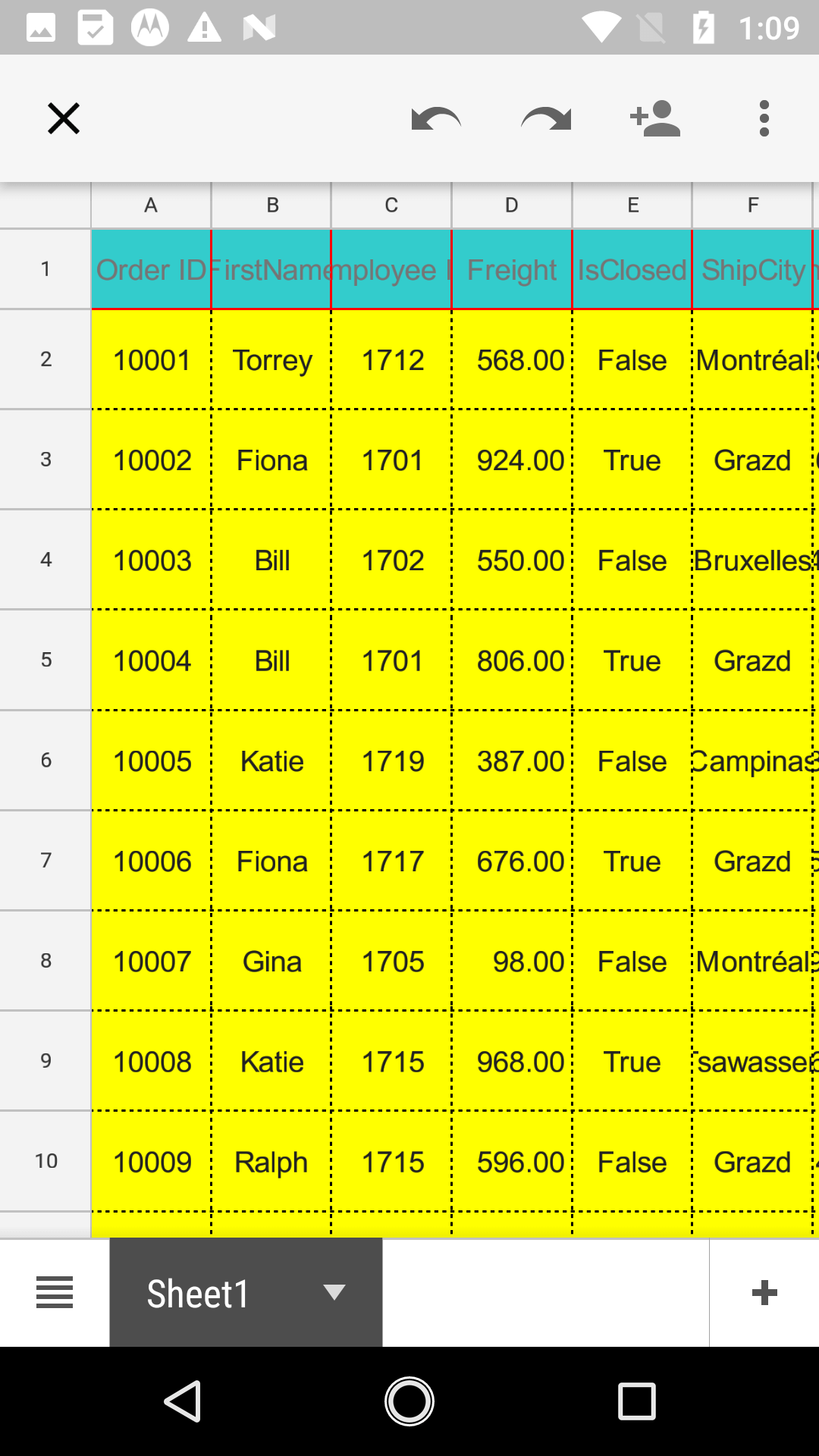
Customize exported workbook and worksheet
Saving a workbook
The following code snippet explains how to save the converted Excel sheet in our local device.
// Need to define the Interfaces in-order to use it in platform wise using Dependency Service
public interface ISave
{
void Save(string filename, string contentType, MemoryStream stream);
}
public interface ISaveWindows
{
Task Save(string filename, string contentType, MemoryStream stream);
}
// In Android renderer project
public class SaveAndroid : ISave
{
public void Save(string filename, string contentType, MemoryStream stream)
{
string exception = string.Empty;
string root = null;
if (Android.OS.Environment.IsExternalStorageEmulated)
{
root = Android.OS.Environment.ExternalStorageDirectory.ToString();
}
else
root = Environment.GetFolderPath(Environment.SpecialFolder.MyDocuments);
Java.IO.File myDir = new Java.IO.File(root + "/Syncfusion");
myDir.Mkdir();
Java.IO.File file = new Java.IO.File(myDir, filename);
if (file.Exists()) file.Delete();
try
{
FileOutputStream outs = new FileOutputStream(file);
outs.Write(stream.ToArray());
outs.Flush();
outs.Close();
}
catch (Exception e)
{
exception = e.ToString();
}
if (file.Exists() && contentType != "application/html")
{
Android.Net.Uri path = Android.Net.Uri.FromFile(file);
string extension = Android.Webkit.MimeTypeMap.GetFileExtensionFromUrl(Android.Net.Uri.FromFile(file).ToString());
string mimeType = Android.Webkit.MimeTypeMap.Singleton.GetMimeTypeFromExtension(extension);
Intent intent = new Intent(Intent.ActionView);
intent.SetDataAndType(path, mimeType);
Forms.Context.StartActivity(Intent.CreateChooser(intent, "Choose App"));
}
}
}
// In iOS renderer project
public class SaveIOS : ISave
{
void ISave.Save(string filename, string contentType, MemoryStream stream)
{
string exception = string.Empty;
string path = Environment.GetFolderPath(Environment.SpecialFolder.Personal);
string filePath = Path.Combine(path, filename);
try
{
FileStream fileStream = File.Open(filePath, FileMode.Create);
stream.Position = 0;
stream.CopyTo(fileStream);
fileStream.Flush();
fileStream.Close();
}
catch (Exception e)
{
exception = e.ToString();
}
if (contentType == "application/html" || exception != string.Empty)
return;
UIViewController currentController = UIApplication.SharedApplication.KeyWindow.RootViewController;
while (currentController.PresentedViewController != null)
currentController = currentController.PresentedViewController;
UIView currentView = currentController.View;
QLPreviewController previewController = new QLPreviewController();
QLPreviewItem item = new QLPreviewItemBundle(filename, filePath);
previewController.DataSource = new PreviewControllerDS(item);
currentController.PresentViewController((UIViewController)previewController, true, (Action)null);
}
}
public class PreviewControllerDS : QLPreviewControllerDataSource
{
private QLPreviewItem _item;
public PreviewControllerDS(QLPreviewItem item)
{
_item = item;
}
public override nint PreviewItemCount (QLPreviewController controller)
{
return (nint)1;
}
public override IQLPreviewItem GetPreviewItem (QLPreviewController controller, nint index)
{
return _item;
}
}
public class QLPreviewItemFileSystem : QLPreviewItem
{
string _fileName, _filePath;
public QLPreviewItemFileSystem(string fileName, string filePath)
{
_fileName = fileName;
_filePath = filePath;
}
public override string ItemTitle
{
get
{
return _fileName;
}
}
public override NSUrl ItemUrl
{
get
{
return NSUrl.FromFilename(_filePath);
}
}
}
public class QLPreviewItemBundle : QLPreviewItem
{
string _fileName, _filePath;
public QLPreviewItemBundle(string fileName, string filePath)
{
_fileName = fileName;
_filePath = filePath;
}
public override string ItemTitle
{
get
{
return _fileName;
}
}
public override NSUrl ItemUrl
{
get
{
var documents = NSBundle.MainBundle.BundlePath;
var lib = Path.Combine(documents, _filePath);
var url = NSUrl.FromFilename(lib);
return url;
}
}
}
// In UWP renderer project
public class SaveWindows : ISaveWindows
{
public async Task Save(string filename, string contentType, MemoryStream stream)
{
if (Device.Idiom != TargetIdiom.Desktop)
{
StorageFolder local = Windows.Storage.ApplicationData.Current.LocalFolder;
StorageFile outFile = await local.CreateFileAsync(filename, CreationCollisionOption.ReplaceExisting);
using (Stream outStream = await outFile.OpenStreamForWriteAsync())
{
outStream.Write(stream.ToArray(), 0, (int)stream.Length);
}
if (contentType != "application/html")
await Windows.System.Launcher.LaunchFileAsync(outFile);
}
else
{
StorageFile storageFile = null;
FileSavePicker savePicker = new FileSavePicker();
savePicker.SuggestedStartLocation = PickerLocationId.Desktop;
savePicker.SuggestedFileName = filename;
switch (contentType)
{
case "application/vnd.openxmlformats-officedocument.presentationml.presentation":
savePicker.FileTypeChoices.Add("PowerPoint Presentation", new List<string>() { ".pptx", });
break;
case "application/msexcel":
savePicker.FileTypeChoices.Add("Excel Files", new List<string>() { ".xlsx", });
break;
case "application/msword":
savePicker.FileTypeChoices.Add("Word Document", new List<string>() { ".docx" });
break;
case "application/pdf":
savePicker.FileTypeChoices.Add("Adobe PDF Document", new List<string>() { ".pdf" });
break;
case "application/html":
savePicker.FileTypeChoices.Add("HTML Files", new List<string>() { ".html" });
break;
}
storageFile = await savePicker.PickSaveFileAsync();
using (Stream outStream = await storageFile.OpenStreamForWriteAsync())
{
outStream.Write(stream.ToArray(), 0, (int)stream.Length);
outStream.Flush();
outStream.Dispose();
}
stream.Flush();
stream.Dispose();
await Windows.System.Launcher.LaunchFileAsync(storageFile);
}
}
}Worksheet customization
Setting borders
The SfDataGrid allows exporting the data to Excel with custom borders style in Excel sheet by handling the CellExporting event.
private void ExcelExport_CellExporting(object sender, DataGridCellExcelExportingEventArgs e)
{
if (e.CellType == ExportCellType.RecordCell)
{
e.Range.CellStyle.BeginUpdate();
e.Range.CellStyle.Borders.LineStyle = Syncfusion.XlsIO.ExcelLineStyle.Dash_dot;
e.Range.CellStyle.Borders[ExcelBordersIndex.DiagonalDown].LineStyle = ExcelLineStyle.Dash_dot;
e.Range.CellStyle.Borders[ExcelBordersIndex.DiagonalUp].LineStyle = ExcelLineStyle.Dash_dot_dot;
e.Range.CellStyle.Borders.Color = ExcelKnownColors.Black;
e.Range.CellStyle.EndUpdate();
}
}
Enabling filters
You can show filters in exported worksheet by enabling filter for the exported range in the worksheet.
var excelExport = new DataGridExcelExportingController();
var options = new DataGridExcelExportingOption();
var excelEngine = excelExport.ExportToExcel(dataGrid, options);
var workBook = excelEngine.Excel.Workbooks[0];
workBook.Worksheets[0].AutoFilters.FilterRange = workBook.Worksheets[0].UsedRange;
MemoryStream stream = new MemoryStream();
workBook.SaveAs(stream);While using stacked headers, you can specify the range based on Stacked headers count.
var excelExport = new DataGridExcelExportingController();
var options = new DataGridExcelExportingOption();
options.ExportStackedHeaders = true;
var excelEngine = excelExport.ExportToExcel(dataGrid, options);
var workBook = excelEngine.Excel.Workbooks[0];
var range = "A" + (dataGrid.StackedHeaderRows.Count + 1).ToString() + ":" + workBook.Worksheets[0].UsedRange.End.AddressLocal;
excelEngine.Excel.Workbooks[0].Worksheets[0].AutoFilters.FilterRange = workBook.Worksheets[0].Range[range];
workBook.SaveAs("Sample.xlsx");
MemoryStream stream = new MemoryStream();
workBook.SaveAs(stream);Customize the range of cells
You can customize the range of cells after exporting to Excel by directly manipulating worksheet.
var excelExport = new DataGridExcelExportingController();
var options = new DataGridExcelExportingOption();
options.ExportStackedHeaders = true;
var excelEngine = excelExport.ExportToExcel(dataGrid, options);
var workBook = excelEngine.Excel.Workbooks[0];
workBook.Worksheets[0].Range["A2:A6"].CellStyle.Color = System.Drawing.Color.LightSlateGray;
workBook.Worksheets[0].Range["A2:A6"].CellStyle.Font.Color = ExcelKnownColors.White;
MemoryStream stream = new MemoryStream();
workBook.SaveAs(stream);Performance improvement
Using ExcelExportingOptions.CellsExportingEventHandler to customize settings of each cell will consume more memory and time. So, avoid using CellsExportingEventHandler when customizing large number of cells and instead of you can do the required customizations in the exported sheet.
Formatting column without using CellsExportingEventHandler
You can perform cell level customization such as row-level styling and formatting a particular column in the exported worksheet.
In the following code snippet, NumberFormat for GridNumericColumn column is changed in the exported sheet after exporting without using CellsExportingEventHandler.
Reference: https://help.syncfusion.com/file-formats/xlsio/working-with-cell-or-range-formatting
var excelExport = new DataGridExcelExportingController();
var options = new DataGridExcelExportingOption();
options.ExportMode = ExportMode.Value;
var excelEngine = excelExport.ExportToExcel(dataGrid, options);
var workBook = excelEngine.Excel.Workbooks[0];
workBook.ActiveSheet.Columns[4].NumberFormat = "0.0";Alternate row styling without using CellsExportingEventHandler
In the following code snippet, the background color of the rows in Excel is changed based on the row index using conditional formatting for better performance.
Reference: https://help.syncfusion.com/file-formats/xlsio/working-with-conditional-formatting
var excelExport = new DataGridExcelExportingController();
var options = new DataGridExcelExportingOption();
options.ExportMode = ExportMode.Value;
var excelEngine = excelExport.ExportToExcel(dataGrid, options);
var workBook = excelEngine.Excel.Workbooks[0];
IConditionalFormats condition = workBook.ActiveSheet.Range[2,1,this.dataGrid.View.Records.Count+1,this.dataGrid.Columns.Count].ConditionalFormats;
IConditionalFormat condition1 = condition.AddCondition();
condition1.FormatType = ExcelCFType.Formula;
condition1.FirstFormula = "MOD(ROW(),2)=0";
condition1.BackColorRGB = System.Drawing.Color.Pink;
IConditionalFormat condition2 = condition.AddCondition();
condition2.FormatType = ExcelCFType.Formula;
condition2.FirstFormula = "MOD(ROW(),2)=1";
condition2.BackColorRGB = System.Drawing.Color.LightGray;Exporting the selected rows of SfDataGrid
SfDataGrid allows you to export only the currently selected rows in the grid to the worksheet using the DataGridExcelExportingController.ExportToExcel method by passing the instance of the SfDataGrid and SfDataGrid.SelectedItems collection as an argument.
Refer the below code to export the selected rows alone to Excel.
private void ExPortToExcel(object sender, EventArgs e)
{
DataGridExcelExportingController excelExport = new DataGridExcelExportingController();
ObservableCollection<object> selectedItems = dataGrid.SelectedItems;
var excelEngine = excelExport.ExportToExcel(this.dataGrid, selectedItems);
var workbook = excelEngine.Excel.Workbooks[0];
MemoryStream stream = new MemoryStream();
workbook.SaveAs(stream);
workbook.Close();
excelEngine.Dispose();
if (Device.RuntimePlatform == Device.UWP)
Xamarin.Forms.DependencyService.Get<ISaveWindowsPhone>().Save("DataGrid.xlsx", "application/msexcel", stream);
else
Xamarin.Forms.DependencyService.Get<ISave>().Save("DataGrid.xlsx", "application/msexcel", stream);
}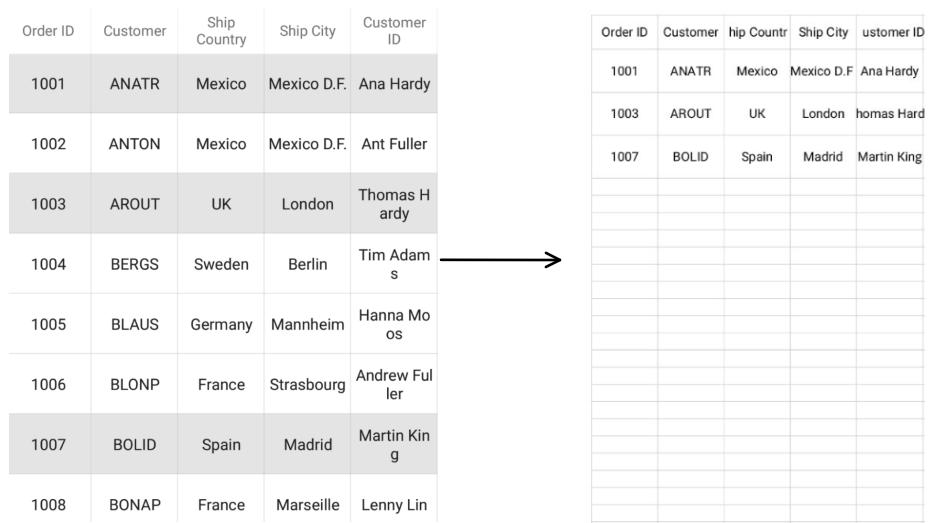
NOTE
You can refer to our Xamarin DataGrid feature tour page for its groundbreaking feature representations. You can also explore our Xamarin.Forms DataGrid example to knows various chart types and how to easily configured with built-in support for creating stunning visual effects.
See also
How to export a SfDataGrid to excel or PDF using ToolBarItems of a Page